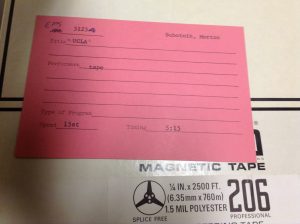
Getting Started:
After several months of planning, the EMS Cataloging project has begun and I have been able to spend a little time with the materials..
Some first impressions:
The EMS collection is a mix of cataloged and uncatalogued recorded materials and some ephemera. A physical catalog, of sorts, was created by the esteemed Scott Wyatt to document some of the sound recordings.
With the help of Scott and Dr. Fieldsteel, I have located a wooden box with a index card catalog with information on some (but not all) magnetic recordings. I also located two folders that appear to have some information about some of the recordings. Such information includes tape title, speed, catalog number, track information, length of recording, and occasionally some information regarding originating studio, master or copy, etc. Many items are not cataloged.
The types of media include:
- Analog magnetic recording tape (mostly ¼” but some ½”).
- LPs, EPs, Flexi grooved media (i.e. records)
- Compact discs
- At least one CD-ROM
- Paper materials including books and ephemera.
Where to start:
This is a big (and tremendously exciting) project.
Here’s the top priorities so far:
- I need to understand what recordings are unique to this collection. Unique and master recordings are the top priority for preservation.
- The existing physical catalog needs to be digitized. By having a digital catalog of the holdings we can be begin to understand what is unique to the collection. We can also build on that database when other items start to get cataloged. That said, the original index-card catalog is an interesting object in of itself and should be preserved in the UIUC archives.
- In considering how to create a database of items (i.e. a digital catalog), important considerations must be planned out ahead of time. For example, a digital catalog can be created using Excel (or a similar cloud based application). I could also create a catalog using something like Access or SQL. The advantage of using something simple like Excel is that others can easily use it and add to it. Unfortunately, such a “flat” database (like Excel) does present some problems when considering that one tape can have multiple authors, songs, recording locations, etc. Such dynamic information is better suited for a more robust database. These considerations must be addressed ASAP.
- A damage/risk assessment must also be done for the materials.
Regarding the recorded content, here’s the metadata (i.e. information about the EMS content) that I’m anticipating putting in a catalog:
- Author(s)
- Catalog Number
- Number of tracks
- Title of tracks
- Time/length of tracks
- Information about recording location (or studio)
- If the item is commercially available or is available in the University of Illinois Library Catalog
- Any hand-written notes on the case
- Speed of playback
- Provenance (master copy, copy, etc.)
- Year of recording(s)
- Tape size (1/4”, ½” etc.)
- UIUC Significance (I’m not sure about this category but it might be nice to be able to search for faculty and students)
- Format of recording (once we move beyond Scott Wyatt’s original catalog, we’re going to have to specify for the mediums of LPs, DATs, CDs. CD-ROMs, tape, etc.).
Immediate To-Do
Much more meetings need to be had all around campus. There are resources that will need to be utilized around campus including: The University of Illinois Archives, the Rare Book and Manuscript Library, the Music Library, the Preservation lab, and maybe the Grainger Engineering Library.
Next week:
I will begin to create a digital catalog of the materials and I will also decide on a temporary digital catalog format.
Meet with Dr. Fieldsteel and discuss potential University of Illinois repositories for various items. Also evaluate the uniqueness of items in the EMS.

